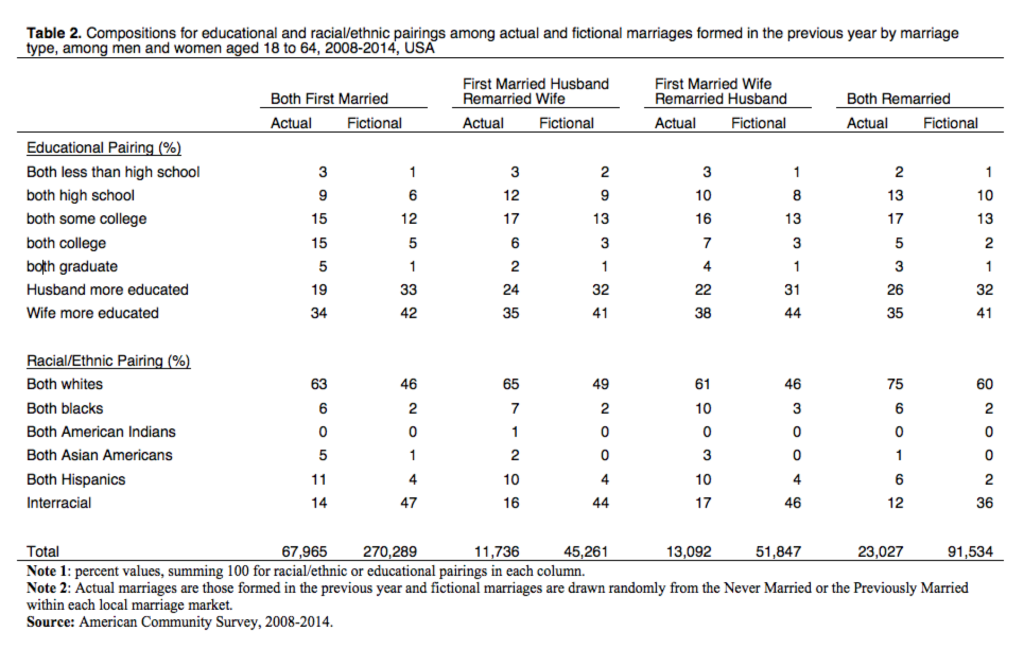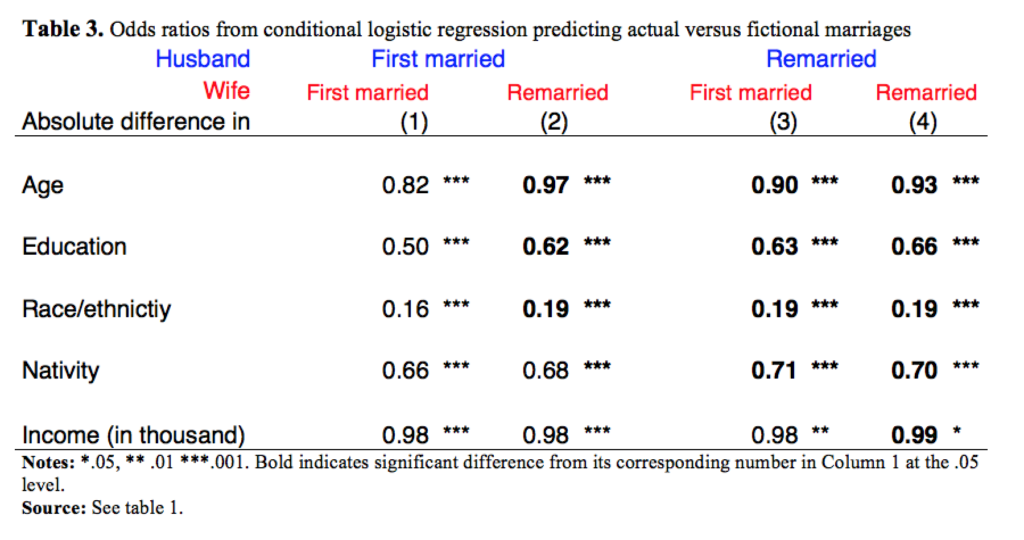Using data from the American Community Survey 2008-2014, Zhenchao Qian and Daniel T. Lichter show how assortative mating patterns are subject to local marriage market conditions.
They also find that previously married individuals are disadvantaged in the marriage market and tend to form heterogamous unions in which they substitute valued traits for marriage with never married persons.
Love and marriage are not random. Men and women typically form marriages on the basis of shared social, demographic, and economic characteristics (Qian and Lichter 2007; Schwartz and Mare 2005). But this matching process – assortative mating – has become complex due to increases in divorce and remarriage. Almost half of all U.S. marriages annually involve previously married persons (U.S. Census Bureau 2010). Remarried persons have been doubly selected into divorce and another marriage, and are therefore probably different from first married persons.
As we argue in this article, mixed-order marriages between never-married and previously married persons may involve exchanges of valued traits between marital partners, especially if being never-married is more highly valued than being divorced (Qian and Lichter 2018). Equitable trades in the marriage market also are subject to the availability of potential marital partners in local marriage market areas. Divorced persons, especially women, face serious deficits in the supply of suitable marital partners, i.e., those matched on similar characteristics.
Getting married
Table 1 highlights the contemporary patterns of the marriages newly formed in the previous year among women aged 18-64, with data from American Community Survey, 2008-2014. Among never married women, 58% were non-Hispanic white, 19% were African American, and 5% were Asian American. Yet, disproportionately more white women (70% and 67%) and fewer African American women (7% and 11%) formed first marriages and remarriages. More white women also were previously married than never married (68% versus 58%). The proportion of White women was greater among remarriages too (72% and 80%, respectively), reflecting large racial differences in remarriage.
Highly educated individuals were more likely to form first marriages and remarriages in the previous year than their less-educated counterparts. Highly educated men and women were overrepresented among marriages in which both spouses were first married. Remarriages also involve partners with more schooling, underscoring the importance of economic resources in marriage.
Marriage market opportunities
We assume that men and women seek the best match possible, and that assortative mating may reflect opportunities or deficits imposed by local marriage market conditions. Divorced persons may face deficits of available partners, which causes them to adjust their aspirations for an equitable exchange in marriage. Our central hypothesis is that divorced persons are more likely to marry “down”, trading their own valued resources (such as higher education) for never-married partners with fewer resources (e.g., low education).
We examined the observed traits of marital partners (the married individual and his/her actual spouse) with those of randomly drawn partners (the married individual and his/her fictional spouse) living in a given U.S. metropolitan area. A comparison between actual and “fictional spouses” reflects differences in actual marriages formed (marital preferences) and fictional marriages randomly selected from local marriage markets (marriage opportunities).
Shown in Table 2, educational assortative mating was most evident among first marriages: one-fifth involved partners with a college- or graduate-level education, a figure more than three times the percentage among fictional marriages (6%). Among remarriages, positive educational assortative mating was less evident; remarriages included disproportionately large shares of partners with unequal education levels. Racial endogamy also was at levels in excess of expectations based on opportunities. Among first marriages, 86% of the actual couples but only 53% of the fictional couples were racially endogamous. Among marriages in which both spouses were remarried, the corresponding percentages were 88% and 64%, respectively.

Models of Intermarriage
We apply conditional logit models to capture assortative mating patterns relative to marriage opportunities, as shown in Table 3. Findings include:
- Each one-year age difference between partners would reduce the odds ratio of forming an actual marriage versus a fictional marriage by 18%. Age homogamy is weaker when one or both spouses are remarried. Remarriages are more age heterogamous than first marriages.
- A one-level difference in education reduces the odds ratio of actual marriages versus fictional marriages by, respectively, 50%, 38%, 37%, and 34% for first marriages and each type of remarriage. Educational homogamy is normative but strongest among first marriages.
- Each $1,000 difference in spousal income reduces the odds ratio of actual versus fictional marriages by approximately 2%. Yet, odds ratios are reduced only by 1% for couples involving two remarried partners. Additional analysis shows a strong likelihood of marriage when husbands’ earnings are equivalent to or more than those of their wives. Furthermore, the odds of pairings in which wives have incomes exceeding their husbands in any type of remarriage are significantly higher than those for first marriages.
- The odds ratio for couples with dissimilar racial or ethnic backgrounds is low in first marriages and remarriages, indicating racial endogamy to be the norm. For any type of remarriage, the odds ratio of interracial pairing remains low but is significantly higher than for first marriage.
- Same-nativity marriages are more common than mixed-nativity marriages. Additional analysis shows likely marriages between never-married immigrant women and remarried U.S.-born men, suggesting a pattern of exchange.
- The presence of children aged 1 or older (presumably from previous relationships) reduces the odds ratio of actual versus fictional marriages by two-thirds vis-à-vis marriages involving two never-married partners with no such children. Among partners with children from previous relationships, mixed-order marriages are more common than first marriages.

Implications
These findings demonstrate that positive assortative mating or homogamy in remarriages is much weaker than in first marriages—on many different ascribed and achieved characteristics. Divorced persons seemingly “cast a wider net” in the search for mates. The only exception is that men and women, in seeking partners for first marriage or remarriage, apparently do not compromise on their aspirations for a spouse with high income.
Contemporary mate selection patterns provide clear evidence of exchanges in the marriage market. Never-married persons are highly valued. Compared with divorced persons, never-married persons are better able to exchange their never-married status for higher-SES partners drawn from the previously married population. Marriage order and SES represent traits for exchange. Deviations from norms of marital homogamy at least partly reflect local demographic shortages of similar potential partners, which are necessary for an equitable exchange.
Remarriages represent a growing share of all marriages in the United States and often include partners with different personal characteristics and more complicated relationship histories. Remarriage imposes an ambiguous set of role obligations and normative constraints on family life, which makes previously married persons arguably less attractive in the marriage market (de Graaf and Kalmijn 2003). Patterns of marital homogamy between first marriages and remarriages reflect different marital preferences, disparate marriage market conditions, and unequal exchanges with partners who bring different traits to the marital market. Growing shares of previously married persons are fundamentally changing U.S. marriage market conditions.
References
de Graaf, Paul M. and Matthijs Kalmijn. 2003. “Alternative Routes in the Remarriage Market: Competing-Risk Analyses of Union Formation after Divorce.” Social Forces 81:1459-1498.
Qian, Zhenchao and Daniel T. Lichter. 2007. “Social Boundaries and Marital Assimilation: Interpreting Trends in Racial and Ethnic Intermarriage.” American Sociological Review 72:68-94.
Qian, Zhenchao and Daniel T. Lichter. 2018. “Marriage Markets and Intermarriage: Exchange in First Marriages and Remarriages.” Demography 55:849-75.
Schwartz, Christine R. and Robert D. Mare. 2005. “Trends in Educational Assortative Marriage From 1940 To 2003.” Demography 42:621-646.
U.S. Census Bureau. 2010. Statistical Abstract of the United States. Washington DC: Government Printing Office.


